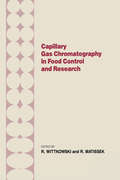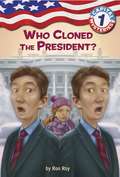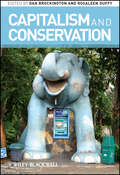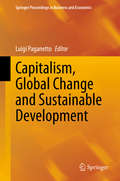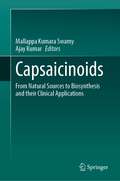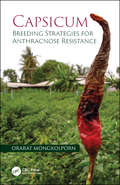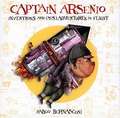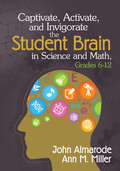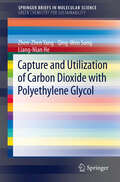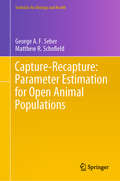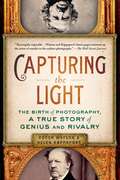- Table View
- List View
Capillary Gas Chromotography in Food Control and Research
by R. WittkowskiThis book offers a comprehensive survey on the possibilities, applications, and new developments of capillary gas chromatography for the complete range of examinations of food and raw material. It is intended for food scientists/chemists, food technologists, and nutritionists.
Capital Cities and Urban Sustainability (Advances in Urban Sustainability)
by Robert W. OrttungCapital Cities and Urban Sustainability examines how capital cities use their unique hub resources to develop and disseminate innovative policy solutions to promote sustainability. Cities are taking a leading role in defining a sustainable future at a time when national, state, and regional governments in several countries do not provide sufficient leadership. Capital cities stand out among cities as likely leading drivers in the effort to empower sustainable innovation as they provide a hub for connecting a variety of key constituencies. While acknowledging the successes capital cities have achieved, the international, multi-disciplinary contributors to this work discuss how there is room to do more and improve. The promotion of specific sustainability policies in crucial areas such as clean water provision, high tech innovation, public procurement contracting, and improving flood control in capital cities is examined through various global case studies. The examples range from relatively rich capital cities, such as Copenhagen, where the well-financed hub would be expected to succeed in generating sustainable policies, to poorer cities such as Phnom Penh, where such an optimistic outcome can seem less likely.
Capital Mysteries #1: Who Cloned the President?
by Ron Roy Liza WoodruffKC Corcoran always watches the news. So it's no surprise that she notices right away when the president starts acting funny on TV. He's stiff and awkward. He's even signing papers with the wrong hand. There's only one explanation-the president has been cloned! And it's up to KC and her best friend, Marshall, to save him.From the Trade Paperback edition.
Capitalism and Conservation: Conservation, Capitalism And The Future Of Protected Areas (Antipode Book Series #45)
by Rosaleen Duffy Dan BrockingtonThrough a series of case studies from around the world, Capitalism and Conservation presents a critique of conservation’s role as a central driver of global capitalism. Features innovative new research on case studies on the connections between capitalism and conservation drawn from all over the world Examines some of our most popular leisure pursuits and consumption habits to uncover the ways they drive and deepen global capitalism Reveals the increase in intensity and variety of forms of capitalist conservation throughout the world
Capitalism and the Commons: Just Commons in the Era of Multiple Crises (Routledge Studies in Global Land and Resource Grabbing)
by Andreas Exner Sarah Kumnig Stephan HochleithnerCapitalism and the Commons focuses on the political and social perspectives that commons offer, how they are appropriated or suppressed by capital and state, and how social initiatives and movements contest these dynamics or build their struggles on commoning. The volume comprises theoretical and empirical approaches that engage with three main themes: conceptualizing the commons, analyzing practices of commoning, and exploring commons politics. In their contributions, the authors focus on the development of anti-capitalist commons and explore the issue of practice and politics through case studies from Colombia, the Democratic Republic of Congo, South Africa, and Africa more broadly, Austria, Germany and South Korea, ranging from peri-urban and rural agriculture to urban commons and how they manifest in the Global South as well as in the Global North. The book engages with different discourses on the commons in regard to their relevance for social change and thereby reinvigorates the political meaning of the commons. It provides an original and important approach to the topic in terms of conceptualization, detailing diverse empirical realities, and analyzing potential perspectives. In so doing, the book transcends narrow disciplinary boundaries and expands the focus to the global. Providing a fresh perspective on the commons as a decisive component of alternatives, this title will be relevant to scholars and students of resource management, social movements, and sustainable development more broadly.
Capitalism, Global Change and Sustainable Development (Springer Proceedings in Business and Economics)
by Luigi PaganettoThis book analyzes new forms of capitalism that are manifesting under the pressures of global transformation. By studying economic and environmental indicators in various parts of the world, it seeks to reconcile economic growth with environmental and social sustainability, which is an important issue in both developed and emerging economies. These indicators include the explosive development of digital technologies and new global value chains, which are reshaping economies and societies all over the world. The contributing authors also address the challenge of immigration, the sustainable development transformation, the ties between productivity and social rights, automation and global value chains, the energy transition, and innovation and sustainable growth.
Capitalizing on Nature
by Edward B. BarbierThe basic unit of nature - the ecosystem - is a special form of wealth, which we can think of as a stock of natural capital. However, perhaps because this capital is free, we have tended to view it as limitless, abundant and always available for our use, exploitation and conversion. Capitalizing on Nature shows how modeling ecosystems as natural capital can help us to analyze the economic behavior that has led to the overuse of so much ecological wealth. It explains how this concept of ecosystem as natural capital sheds light on a number of important issues, including landscape conversion, ecological restoration, ecosystem resilience and collapse, spatial benefits and payments for ecosystem services. The book concludes by focusing on major policy challenges that need to be overcome in order to avert the worsening problem of ecological scarcity and how we can fund novel financing mechanisms for global conservation.
Capsaicinoids: From Natural Sources to Biosynthesis and their Clinical Applications
by Ajay Kumar Mallappa Kumara SwamyThis edited book brings out a comprehensive collection of information on capsaicinoids. Primarily, this book includes compiled knowledge on various aspects of capsaicin from ethnobotany to the most important clinical applications. This book covers topics emphasizing chemistry, biosynthesis, anticancer activities, bioavailability, currently undergoing experimental phases, and biotechnological methods, including cell cultures, and metabolic engineering in heterologous microbial and plant systems to enhance capsaicin production. Capsaicinoids are a group of important compounds that are particularly synthesized by various members of the genus Capsicum in their placenta. Capsaicin is the most abundant vanilloid compound among the different capsaicinoids in hot peppers. Other capsaicinoids include dihydrocapsaicin, nordihydrocapsaicin, homocapsaicin, and homodihydrocapsaicin. The capsaicin has been proven as an important bioactive molecule with several properties against many ailments, such as cancer, diabetes, obesity and diseases of the airway and urinary tract. Capsaicin interacts with TRPV1 receptors in humans. These compounds exert their functions by interacting with the TRPV receptors. This book summarises the increasing literature surrounding capsaicin and helps to pave the way for the development of novel targets for the prevention and treatment of many disorders. It is useful for scientists, clinicians, and industry specialists working in the field of herbal therapeutics. It also assists as supplementary reading material for undergraduate and graduate students of botany, biotechnology, biochemistry, bioengineering, pharmacology, and medicine.
Capsicum: Breeding Strategies for Anthracnose Resistance
by Orarat MongkolpornCapsicum, more commonly as chili or chili pepper, is an important global vegetable and spice crop. Anthracnose disease, caused by a complex of Colletotrichum species, is the major biotic stress limiting chili production in tropical and subtropical countries. Anthracnose disease mainly manifests itself as a post-harvest disease, resulting in large necrotic lesions on the fruit. This disease is mainly controlled by the application of a "cocktail" of fungicides as commercial resistant cultivars are not available. In recent years, insights into the complexity of the pathogen and the genomics of the host have been accomplished using cutting-edge molecular technologies. The author has been at the forefront of this technology revolution in Capsicum breeding through her research to understand the host and pathogen which has led to the development of new anthracnose resistant genotypes. Capsicum: Breeding Strategies for Anthracnose Resistance is structured based on a review of the origin and evolution of Capsicum, Capsicum genetic diversity and germplasm resources, the latest research in the biology and taxonomy of Colletotrichum pathogens of Capsicum, and the classic and molecular breeding for resistance in Capsicum to the suite of Colletotrichum pathogens that infect Capsicum globally. This book brings together knowledge on both the pathogen and the host, which is often overlooked when reviewing the breeding and genetics of a crop plant. It informs the facts behind breeding for resistance from both the host and pathogen perspectives.
Capsicum: The genus Capsicum (Medicinal And Aromatic Plants Industrial Profiles #33)
by Amit Krishna DeCapsicum has been used since ancient times not only as a traditional medicine but also as a natural colorant. The medicinal properties of capsicum make it popular in both ayurvedic and homeopathic treatments.
Captain Arsenio
by Pablo BernasconiCaptain Arsenio was a curious man who liked, more than anything, to tinker and explore. One day in 1782, he decided that he would put his unusual skills to work in a most ambitious way: he would build a flying machine. Despite a hodgepodge of materials (and a total unawareness of the laws of physics), Captain Arsenio aimed to get his feet off the ground and his head in the clouds-temporarily, at least. But would any of his crazy inventions ever achieve flight? In this hilarious fictional account, Pablo Bernasconi imagines a legend in the making-a retired cheesemaker and scuba diver turned inventor who sets off to fly with the birds, in spite of himself.
Captivate, Activate, and Invigorate the Student Brain in Science and Math, Grades 6-12
by John T. Almarode Ann M. MillerBanish boredom once and for all! If your STEM lessons are falling on disinterested ears, mix things up with engaging, brain-based science and math strategies that captivate students’ attention, activate prior knowledge, and invigorate interest. Blending current research on the student brain with practical methods for teaching science and math, Almarode and Miller identify six essential “ingredients” in a recipe for student success. You’ll discover: A customizable framework you can use right away Classroom-ready, content-specific attention grabbers Overt and covert strategies to boost behavioral, emotional, and cognitive engagement Techniques for making relevant connections that maximize retention
Capture and Utilization of Carbon Dioxide with Polyethylene Glycol (SpringerBriefs in Molecular Science)
by Qing-Wen Song Liang-Nian He Zhen-Zhen YangIn this volume, Professor He and his coworkers summarize polyethylene glycol (PEG)-promoted CO2 chemistry on the basis of understanding about phase behavior of PEG/CO2 system and reaction mechanism at molecular level. As PEG could be utilized as a green replacement for organic solvents, phase-transfer catalyst, surfactant, support in various reaction systems, significantly promoting catalytic activity and recovering expensive metal catalysts, particularly regarded as a CO2-philic material, the authors focus on special applications of PEG in CO2 capture and utilization, including PEG-functionalized catalysts for efficient transformation of CO2 and PEG-functionalized absorbents for efficient CO2 capture. Furthermore, they describe carbon capture and utilization strategy as an alternative approach to address the energy penalty problem in carbon capture and storage. Interestingly, the authors also discuss PEG radical chemistry in dense CO2 as rather creative and unusual use of PEG, presumably serves as a reaction medium and a radical initiator for radical chemistry.
Capture-Recapture: Parameter Estimation for Open Animal Populations (Statistics for Biology and Health)
by Matthew R. Schofield George A. SeberThis comprehensive book, rich with applications, offers a quantitative framework for the analysis of the various capture-recapture models for open animal populations, while also addressing associated computational methods. The state of our wildlife populations provides a litmus test for the state of our environment, especially in light of global warming and the increasing pollution of our land, seas, and air. In addition to monitoring our food resources such as fisheries, we need to protect endangered species from the effects of human activities (e.g. rhinos, whales, or encroachments on the habitat of orangutans). Pests must be be controlled, whether insects or viruses, and we need to cope with growing feral populations such as opossums, rabbits, and pigs. Accordingly, we need to obtain information about a given population’s dynamics, concerning e.g. mortality, birth, growth, breeding, sex, and migration, and determine whether the respective population is increasing , static, or declining. There are many methods for obtaining population information, but the most useful (and most work-intensive) is generically known as “capture-recapture,” where we mark or tag a representative sample of individuals from the population and follow that sample over time using recaptures, resightings, or dead recoveries. Marks can be natural, such as stripes, fin profiles, and even DNA; or artificial, such as spots on insects. Attached tags can, for example, be simple bands or streamers, or more sophisticated variants such as radio and sonic transmitters. To estimate population parameters, sophisticated and complex mathematical models have been devised on the basis of recapture information and computer packages. This book addresses the analysis of such models. It is primarily intended for ecologists and wildlife managers who wish to apply the methods to the types of problems discussed above, though it will also benefit researchers and graduate students in ecology. Familiarity with basic statistical concepts is essential.
Captured by Aliens: The Search for Life and Truth in a Very Large Universe
by Joel AchenbachWhat we have learned or suspect about the universe.
Capturing The Light: The Birth Of Photography, A True Story Of Genius And Rivalry
by Helen Rappaport Roger WatsonAn intimate look at the journeys of two men―a gentleman scientist and a visionary artist―as they struggled to capture the world around them, and in the process invented modern photography During the 1830s, in an atmosphere of intense scientific enquiry fostered by the industrial revolution, two quite different men―one in France, one in England―developed their own dramatically different photographic processes in total ignorance of each other's work. These two lone geniuses―Henry Fox Talbot in the seclusion of his English country estate at Lacock Abbey and Louis Daguerre in the heart of post-revolutionary Paris―through diligence, disappointment and sheer hard work overcame extraordinary odds to achieve the one thing man had for centuries been trying to do―to solve the ancient puzzle of how to capture the light and in so doing make nature 'paint its own portrait'. With the creation of their two radically different processes―the Daguerreotype and the Talbotype―these two giants of early photography changed the world and how we see it. Drawing on a wide range of original, contemporary sources and featuring plates in colour, sepia and black and white, many of them rare or previously unseen, Capturing the Light by Roger Watson and Helen Rappaport charts an extraordinary tale of genius, rivalry and human resourcefulness in the quest to produce the world's first photograph.
Capturing Value in Digital Health Eco-Systems: Validating Strategies for Stakeholders
by Felix Lena Stephanie Ravi S. SharmaThe United Nation's Sustainable Development Goals call for the establishment of Good Health and Well-being and target a universal digital healthcare ecosystem by 2030. However, existing technology infrastructure is ineffectual in achieving the envisioned target and requires massive reconfiguration to achieve its intended outcome. This book suggests a way forward with fair and efficient digital health networks that provide resource efficiencies and inclusive access to those who are currently under-served. Specifically, a fair and efficient digital health network that provides a common platform to its key stakeholders to facilitate sharing of information with a view to promote cooperation and maximise benefits. A promising platform for this critical application is ‘cloud technology’ with its offer of computing as a utility and resource sharing. This is an area that has attracted much scholarly attention as it is well-suited to foster such a network and bring together diverse players who would otherwise remain fragmented and be unable to reap the benefits that accrue from cooperation. The fundamental premise is that the notion of value in a digital-health ecosystem is brought about by the sharing and exchange of digital information. However, notwithstanding the potential of information and communication technology to transform the healthcare industry for the better, there are several barriers to its adoption, the most significant one being misaligned incentives for some stakeholders. This book suggests among other findings, that e-health in its true sense can become fair and efficient if and only if a regulatory body concerned assumes responsibility as the custodian of its citizens’ health information so that ‘collaboration for value’ will replace ‘competition for revenue’ as the new axiom in delivering the public good of healthcare through digital networks.
Capturing the Full Power of Biomaterials for Military Medicine: Report of a Workshop
by Committee on Capturing the Full Power of Biomaterials for Military Medical NeedsRecent results in biomaterials R&D suggest that there are exceptional opportunities for these emerging materials in military medicine. To facilitate this possibility, the National Research Council convened a workshop at the request of the Department of Defense to help create a technology development roadmap to enhance military R&D into biomaterials technology. The workshop focused primarily on identifying useful near- and mid-term applications of biomaterials including wound care, tissue engineering, drug delivery, and physiological sensors and diagnostics. This report presents a summary of the workshop. It provides a review of biomaterials and their importance to military medicine, the roadmap, and a discussion of ways to enable biomaterials development. Several important outcomes of successful capture of potential benefits of these materials are also discussed.
Capturing the Light: The Birth of Photography, a True Story of Genius and Rivalry
by Helen Rappaport Roger WatsonAn intimate look at the journeys of two men—a gentleman scientist and a visionary artist—as they struggled to capture the world around them, and in the process invented modern photographyDuring the 1830s, in an atmosphere of intense scientific enquiry fostered by the industrial revolution, two quite different men—one in France, one in England—developed their own dramatically different photographic processes in total ignorance of each other's work. These two lone geniuses—Henry Fox Talbot in the seclusion of his English country estate at Lacock Abbey and Louis Daguerre in the heart of post-revolutionary Paris—through diligence, disappointment and sheer hard work overcame extraordinary odds to achieve the one thing man had for centuries been trying to do—to solve the ancient puzzle of how to capture the light and in so doing make nature 'paint its own portrait'. With the creation of their two radically different processes—the Daguerreotype and the Talbotype—these two giants of early photography changed the world and how we see it. Drawing on a wide range of original, contemporary sources and featuring plates in colour, sepia and black and white, many of them rare or previously unseen, Capturing the Light by Roger Watson and Helen Rappaport charts an extraordinary tale of genius, rivalry and human resourcefulness in the quest to produce the world's first photograph.
Capturing the Stars: Astrophotography by the Masters
by Robert GendlerPortraits of the deep sky and of local astronomical phenomena taken by the world&’s renowned astrophotographers—with a foreword by Neil deGrasse Tyson. To gaze at the stars is one thing; to capture that gaze in photographs is something else, a tantalizing scientific art that many attempt and few master. That rare mastery is on full display in this beautiful volume of space photography from thirty of the most accomplished astrophotographers in the world, both professional and amateur. Galaxies, star clusters, nebulae, and other deep-sky treasures fill the pages. Along with the marvels of the night sky—the Andromeda and Whirlpool galaxies, the Pleiades and the Praesepe, the Orion and Crab nebulae, and many more—each section features a profile of the photographer&’s work, techniques, philosophy, and experiences. Compiled by the world&’s leading amateur astrophotographer, with an introduction to the history of space photography, this spectacular volume is an essential for every stargazer&’s bookshelf.elf.
Capturing the Universe: A Photographer’s Guide to Deep-Sky Imaging
by Chris WoodhouseThis book provides a thorough introduction to and exploration of deep sky astrophotography for the digital photographer. With over 280 images, graphs, and tables, this introductory book uses a progressive and practical style to teach readers how to image the night sky using existing, affordable equipment. The book opens with a brief astronomy primer, followed by chapters that build progressively to explain the challenges, offer solutions, and provide invaluable information on equipment choice through image capture, calibration, and processing in affordable software. The book’s focus ranges from how to image sweeping vistas and star trails using only a camera body, lens and tripod, to more advanced methods suitable for imaging galaxies, clusters, nebulae, and stars. Other features of the book include: Real-world assignments showing how and when to use certain tools and how to overcome challenges and setbacks Practical construction projects Evaluations of the most recent developments in affordable hardware and software Exploration on how sensor performance and light pollution relate to image quality and exposure planning Ground-breaking practical chapters on lucky imaging and choosing and using the latest CMOS cameras Written in an accessible, easy to follow format, this comprehensive guide equips readers with all the necessary skills to progress from photographer to astrophotographer.
Capybara: Biology, Use and Conservation of an Exceptional Neotropical Species
by Emilio A. Herrera David W. Macdonald José Roberto Moreira Katia Maria FerrazThe capybara is the neotropical mammal with the highest potential for production and domestication. Amongst the favorable characteristics for domestication we can list its high prolificacy, rapid growth rate, a herbivorous diet, social behavior and relative tameness. The genus (with only two species) is found from the Panama Canal to the north of Argentina on the east of the Andes. Chile is the only country in South America where the capybara is not found. The species is eaten all over its range, especially by poor, rural and traditional communities engaged in subsistence hunting. On the other hand, in large urban settlements wildlife is consumed by city dwellers as a delicacy. The sustainable management of capybara in the wild has been adopted by some South American countries, while others have encouraged capybara rearing in captivity.
Car Troubles: Critical Studies of Automobility and Auto-Mobility
by Jim Conley Arlene Tigar<P>Car Troubles central premise is that the car as the dominant mode of travel needs to be problematized.<P> It examines a wide range of issues that are central to automobility by situating it within social, economic, and political contexts, and by combining social theory, specific case studies and policy-oriented analysis. <P>With an international team of contributors the book provides a coherent and comprehensive analysis of the global phenomenon of automobility from the Anglo world to the cases in China and Chile and all the elements that relate to it.
Car Troubles: Critical Studies of Automobility and Auto-Mobility (Transport And Society Ser.)
by Jim ConleyCar Troubles central premise is that the car as the dominant mode of travel needs to be problematized. It examines a wide range of issues that are central to automobility by situating it within social, economic, and political contexts, and by combining social theory, specific case studies and policy-oriented analysis. With an international team of contributors the book provides a coherent and comprehensive analysis of the global phenomenon of automobility from the Anglo world to the cases in China and Chile and all the elements that relate to it.
Caraway: The Genus Carum
by Éva NémethCaraway, the seventh volume in the series Medicinal and Aromatic Plants - Industrial Profiles, collects together all of the existing information in connection with the biology, chemistry, agrotechnology and utilization of the plant genus Carum. After an overview on all Carum species, it deals mainly with th most important species Carum carvi L. The
